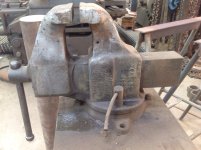I was given an anvil that is at least 70 years old. It is mounted on a stump.
At some point in time, many years ago someone painted the anvil and stump red! The good news is there is hardly any of the red paint left. I think pressure washing will remove any trace of paint on the stump. Wire brushing will clean up the anvil.
The striking plate looks good with hardly any damage on the edges. The tip of the horn is peened over slightly. I plan on smoothing the striking plate and don't know how to straighten out the tip of the horn, but file work may help.
So any suggestions?
Also how were the bases of these anvils finished? Stove black? Or no finish at all? Should I try cold blue?
Thanks
At some point in time, many years ago someone painted the anvil and stump red! The good news is there is hardly any of the red paint left. I think pressure washing will remove any trace of paint on the stump. Wire brushing will clean up the anvil.
The striking plate looks good with hardly any damage on the edges. The tip of the horn is peened over slightly. I plan on smoothing the striking plate and don't know how to straighten out the tip of the horn, but file work may help.
So any suggestions?
Also how were the bases of these anvils finished? Stove black? Or no finish at all? Should I try cold blue?
Thanks


